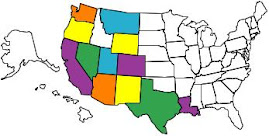Varied information had been given to us regarding Salton Sea, a large body of water, actually a lake, just north of the border with Mexico.The thought however of viewing many thousands of migratory birds which flock to the sea between October and the spring encouraged us to see for ourselves. We took highway 78 and for mile after mile expected to view the water but non appeared we did see irrigation channels and as we got closer to where we thought the west coast should be, agriculture in the form of fruit and vegetable cultivation became very apparent. The town of Brawley existing it seemed on the packaging industry for the surrounding areas, it was actually nice to see at last some of this vast expanse of empty land being utilised.
We had chosen a campground with hot springs for our overnight stay, it was also not near the sea, it looked close on the map but at this point we had only had a distant glimpse of water. We enjoyed a soak in the mineral pool with out door temperatures around 70 degrees at 3pm. The water was hot bath temperature, it rises in an artesian well at 190 degrees then is cooled before being pumped into the six outdoor bathing pools plenty big enough for two people, at a squeeze 4 maybe.
Next morning we set off to find the lake and the birds, we had only to travel a few miles to find the Salt Creek State Beach campground, it was only 10.15 am but the
I spent most of the day watching them through the binoculars, observing the patrols of white pelican fishing as a team and the brown pelican diving head first into the water to catch their prey. Occasionally a gull would manage to catch a fish only to have it confiscated by a pelican before it could be consumed. As the light started to dim many birds flew 

From Salton Sea we made our journey north back to Joshua Tree National Park. Cottonwood Creek campground was virtually empty but never the less it was not easy to find a spot big enough for us to fit in. Eventually we decided we would have to hang over at the rear of one of the largest sites enabling us to just fit in at the front. As we had arrived early in the day we had some lunch before walking out to the Mastodon trail. The first thing we noticed in Joshua Tree Park was how much colder it was, the wind really was very chilly and we needed two layers on when we went out, we soon warmed however as the trail led up and down and through gravelly washes, these are quite hard to walk in, like walking on soft sand which moves quickly from beneath your feet as you put weight on it.

A cool night with temperatures around 40 degrees Fahrenheit made us think twice about a second night in the park. The road through the park travels north then north west. We stopped to read the various makers along the way also taking a short walk through the Cholla cactus garden where you are 
Further along the road and higher in the desert we found the trees the park is named after. The Joshua Tree it seems has been described in many ways
The campground in the north of the park would probably reach an overnight low in the 20’s and we felt to cold to dry camp, the day had been dull and grey not something we are used to any more. It would be a long drive but we decided it was time to leave California behind. I am sure one day we will be back here, we still have some exploring to do in this State of many landscapes and the coast will always draw us west to renew the pleasures of our first months out on the road.


3 comments:
Hi Elaine,
We are curious as to which hot spring campground you were at in Imperial Valley. You mentioned in your blog- 190 degree water and six pools. Was this up at Bashbords or Fountain of Youth? Thanks Kim
Hi, Kim
It was Bashfords, OK for stop over, lots of winter residents there and a few casual visitors too. Fountain of Youth is just along the road and the KOA is close by too. Ar you planning a visit to the area?
Hello Elaine,
Thanks for your post. You seemed have had a great trip! Joshua Tree is a great destination. At Fox Rent A Car Blog we wrote a post about Joshua Tree as well, sharing tips about campgrounds, and sights to visit. We like to give travel advice and share tips about places to stay and visit in different cities and National Parks.
Thanks again for sharing.
Post a Comment